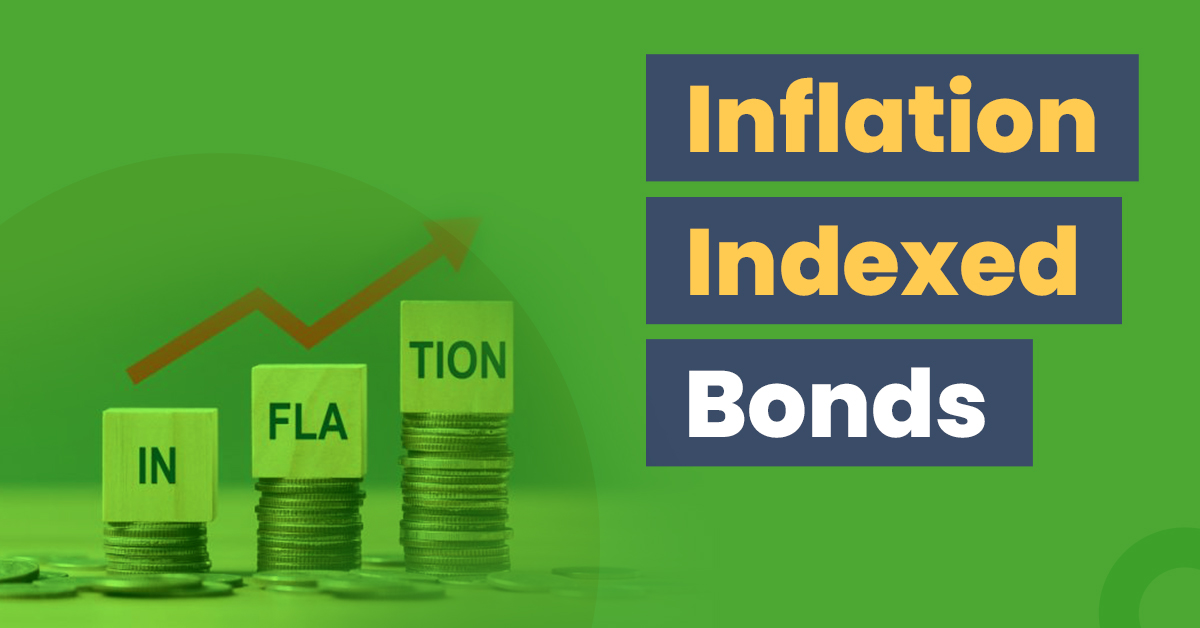Inflation Indexed Bonds: Meaning, Benefits & Risks


Inflation not only affects your household budgets due to a rise in the price of consumption baskets, but it also has a negative impact on investments as the real rate of returns may decline. With inflation being a serious concern for economies worldwide, investors are looking at alternate ways of shielding their investments from its ill effects.
An inflation-indexed bond is a security whose principal amount is linked to the prevailing inflation rates. It allows you to insulate your investments and have a positive real interest rate. Let’s discuss various dimensions related to these debt securities and get a better understanding of them.
What Are Inflation-Indexed Bonds?
As the name suggests, these debt securities are in sync with prevailing inflation rates in an economy. As the rate of inflation changes every month, the principal amount on these bonds is also dynamic and changes at periodic intervals.
Conventional bonds offer a fixed interest rate on the face value or principal amount. As inflation reduces a bond’s value over time, the actual return that you are getting will fall even though interest remains the same.
In contrast, inflation-oriented bonds link the security’s principal amount with the Consumer Price Index, which represents inflation. Therefore, the bond’s face value will rise or fall as per changes occurring in the inflation rate.
Now that you are aware of what inflation-indexed bonds are, let’s move on to other aspects like benefits and risks associated with these.
How Do Inflation Indexed Bonds Work?
In order to get an idea about the working of inflation-indexed bonds, we need to make a comparison with traditional bonds.
This does protect these securities from a fall in their value due to burgeoning inflation. But inflation-indexed bonds offer a minimum rate of return that remains unaffected by the prevailing Consumer Price Index. Issuers link their principal amount to the economy’s inflation rates.
Capital and inflation are directly proportional to each other. A rise in inflation will lead to a corresponding increase in bond prices. As bond issuers compute coupon payments on the principal amount, an increase in the latter will consequently lead to an increase in the former.
But there is a catch here; you would think that whenever there is deflation, your principal amount will fall and, along with it, your interest payments. However, it is not the case; bond value will not fall below the initial investment amount or face value, thereby giving dual protection to your investments.
History of Inflation Indexed Bonds
Inflation, or the Consumer Price Index, is one of the major macroeconomic indicators for any economy. Post-independence India has a history of very high inflation rates when the real rate of return becomes negative.
This problem became extremely serious post the global financial crisis of 2008. As real rates of return started to move into negative territory, a significant amount of investors switched to physical gold. This, in turn, increased the demand for physical gold, which had an adverse impact on the current account deficit. In order to shift investors away from physical gold, the Government of India introduced inflation-indexed bonds on June 04 2013.
Initially, these bonds were tied to the Wholesale Price Index. The Reserve Bank of India (RBI) used to regularly issue these bonds on a monthly basis till December 2013. It used to offer an annual return of 1.44% over the prevailing inflation.
You could trade these bonds on Order Matching Negotiated Dealing System’s over-the-counter market. As per one estimate, RBI issued around ₹6,000 crores of inflation-linked bonds in 2013.
Since 2014, these bonds have been tied to CPI or Consumer Price Index. With inflation moderating over the next few years, these bonds witnessed reduced demand. However, as inflation is again breaching the higher band in 2022, many investors have made a switch to these securities.
Benefits of Investing in Inflation Indexed Bonds
Here are some advantages of investing in these bonds:
- Fixed Yield
One of the major advantages of these bonds is that it provides a fixed and long-term yield after taking inflation into account. It is beneficial for you if you prefer fixed earnings but are apprehensive of the impact of inflation.
- No Inflation Risk
These bonds provide insulation from the adverse impact of inflation. They come with zero inflation risk, i.e. investment is protected against rising Consumer Price Index. On the other hand, traditional bonds face erosion in their value in times of high inflation.
- Hedge Against Inflation
These bonds serve as a hedge against inflation as yields are independent of stock markets. Therefore, it provides much needed diversification to a stock investment portfolio.
Risks of Investing in Inflation Indexed Bonds
Some disadvantages of investing in inflation-linked bonds are as follows:
- Lower Interest Potential
Their return potential is moderate compared to other investment options like stocks and mutual funds. They offer a fixed interest rate, whereas stocks and mutual funds provide compounding returns which is significantly higher.
- Performance During Low Inflation
Whenever inflation is running low, investors will not be attracted towards these securities due to their lower return potential. This may not be an ideal investment when inflation is hovering near the lower band.
- CPI is Not an Ideal Indicator
The Consumer Price Index may not be an ideal indicator to gauge the impact of inflation. As these bonds are linked to CPI, there is an ambiguity regarding their efficacy.
How to Invest in Inflation Indexed Bonds?
The different ways in which you can invest in inflation indexed bonds are as follows:
Inflation Indexed National Savings Securities – Cumulative (IINSS-C)
It is one of the most popular inflation-indexed bonds in India. The Reserve Bank of India regularly issues these bonds through primary auction mode. The principal amount on these bonds is tied to inflation, and it increases or reduces with respect to the corresponding inflation rate. These bonds pay an annual interest of 1.5% over the prevailing inflation rate.
ETFs and Index Funds
You can also go for purchasing units of ETFs or index funds instead of individually purchasing inflation-linked bonds. ETFs and index funds invest in different kinds of debt instruments, including inflation-indexed debt securities. Therefore, you are investing indirectly in the said bonds by putting your money in ETFs.
Final Word
An inflation-indexed bond serves the purpose of protecting investments from rising inflation rates and subsequent falls in the real rate of return. These can be effective investment alternatives if you are looking to insulate the portfolio from inflation risks and shocks.
Frequently Asked Questions
Q1. Can you prematurely exit from inflation indexed bonds?
Ans. Yes, you can prematurely exit from these bonds before the end of maturity period. It operates like any other government security, and you can trade them at your convenience. Therefore, it offers high liquidity.
Q2. What is the taxation scenario of inflation-indexed bonds?
Ans. The interest received on these bonds is subject to taxation as per respective tax slabs. Moreover, capital gains accrued from these are taxable as per the holding period. If the holding period is 36 months or more, long-term capital gains tax is applicable. However, if the holding period is less than 36 months, it comes under short-term capital gains tax.
Q3. What is the minimum investment amount of inflation indexed bonds?
Ans. The minimum investment amount in these bonds is ₹5,000. On the other hand, the maximum investment amount is ₹10 lakh for individual investors.
Q4. How is interest paid on inflation indexed bonds?
Ans. The minimum investment amount in these bonds is ₹5,000. On the other hand, the maximum investment amount is ₹10 lakh for individual investors.




